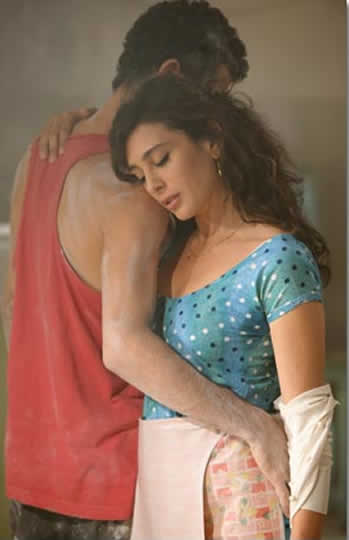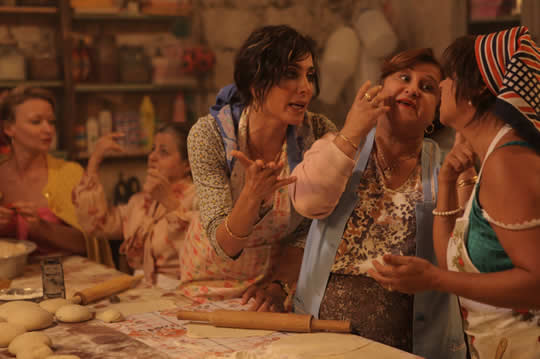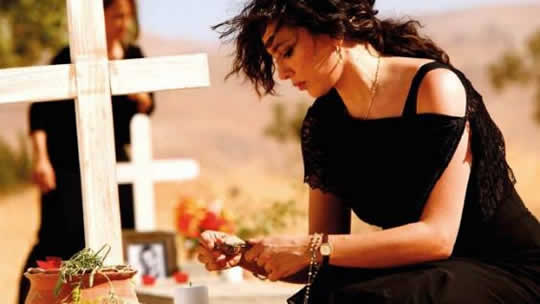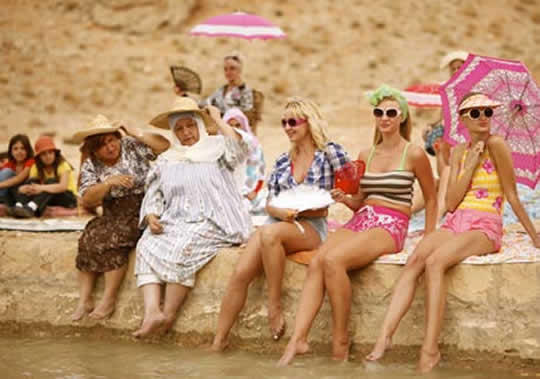Set in a remote village where the church and the mosque stand side by side, Where Do We Go Now? follows the antics of the town’s women to keep their blowhard men from starting a religious war. Women heartsick over sons, husbands and fathers lost to previous flare-ups unite to distract their men with clever ruses, from faking a miracle to hiring a troop of Ukrainian strippers.
Nadine Labaki, writer and director of the Where Do We Go Now?, Lebanon’s Oscar 2012 selection, was born in 1974 in Lebanon. She received a degree in film studies at Beirut’s Saint-Joseph University (IESAV) where she directed her final end of year project, 11 rue Pasteur, in 1997. The film won the award for the best short film of the Biennale of Arabic Cinema held at Institute of the Arabic World in 1998.
Nadine participated in the Residence at the Cannes Film Festival where she finished writing Caramel, her first feature film which she directed in 2006. Caramel was presented at the Director’s Fortnight in Cannes in 2007 and was a success in France in the summer of the year.
Bijan Tehrani: How did you come up with the idea of Where Do We Go Now?
Nadine Labaki: When you live and grow up in a region stewing in turmoil such as the Middle East [and specifically in a country like Lebanon where it is very unstable and the excuse to start a war is always available], making a film becomes your cry for help. Making a film becomes a need for you to express your frustration, your needs, your anxieties and your naïve attempt to change the world – to rise up against the injustice that you see around you.
In May 7 of 2008, a series of political events in Lebanon lead people, who belonged to opposing political parties, to hold weapons against each other. Brothers nurtured by the same mother, neighbors and friends turned into enemies again and within a matter of hours – after having lived in peace for over two decades since the civil war ended. In the midst of all this turmoil, I had just learned that I was pregnant with my first child. Facing such absurd and violent events, I couldn’t help but think of my future son. I imagined him all grown up. Will he also walk past me carrying a weapon to fight in the streets someday? How far will I be willing to go to stop him?
Believing that cinema can be one of the most powerful nonviolent weapons to trigger change, I decided to write the story of a mother who was going to try everything she can to stop her son from resorting to violence. And slowly, it developed into the story of a whole village where women were going to do everything they can to stop their men from engaging in a bloody war.
BT: In Where Do We Go Now you have two parallel layers of humor and tragedy. How did you manage to keep the balance between these two layers?
NL: When you live in a place where the situation is very complicated, you feel that nothing makes sense unfortunately. The situation is sometimes so absurd that you cannot help but laugh about it. Humor becomes the remedy – the only way to distance yourself from the situation, to measure your flaws and hopefully to start healing. Being ironic becomes your only solution. I was also inspired by all these women that I know, who have been through so much tragedy due to the war but who still manage to keep their sense of humor. Anyway, isn’t this what real life is? Never one way or the other? Good moments and bad moments? It was a challenge tackling two opposite extreme emotions. I took the risk without really knowing if it would work, while deeply believing that this is how it should be.
 BT: Is this film based just on your imagination or it comes from your personal experience or observation of other people’ lives?
BT: Is this film based just on your imagination or it comes from your personal experience or observation of other people’ lives?
NL: Where Do We Go Now is a combination of both. On the one hand, I rely a lot on observation – especially when I am working with actors. I like to flirt with reality. The more realistic it is the better. I’m inspired by people I know, people I meet, people I observe or notice and people that catch my attention. This is why I work most of the time with unprofessional actors. They are common people from everyday life. My challenge is to give the viewer the impression that he/she is watching people that look like him/her. I think it allows people to identify more easily with the characters and with the story itself. And maybe this pushes them to reflect on their own life – thus achieving a certain change. The subject of the film is inspired by countless true stories, which happen in our community and elsewhere. But it was important not to tie it to any specific time or place. In the film, these conflicts occur between Christians and Muslims in a village that is supposed to be situated in Lebanon. But actually, these conflicts could have happened anywhere, anytime and between any two human beings. They could have happened between two football teams, two families, two neighbors, two friends, or two brothers. This is where I had to rely on imagination and add a fairy tale approach to the film. The music and the dancing in the film helped in creating this unrealistic atmosphere, and this allowed me to tackle very delicate subjects such as religion [especially in our part of the world] and get away with it. An example about the mixture of realism with fantasy is the opening scene of the movie where I integrate the ritual of women wearing black and visiting the graves of their loved ones. You see an imaginative dance that represents the grieving that they endure inside their heads. This allows us to achieve a meeting point between both imagination and reality.
BT: You have a large number of actors in your film; how challenging was casting of Where Do We Go Now and how did you go about it?
NL: The casting process was a very long and delicate one, considering the fact that I mainly used unprofessional actors. The talent hunting team consisted of at least fifteen very hard working people. They looked everywhere across the country for the right characters. We even put ads in newspapers asking for people from every walk of life and with no prior experience to audition. I saw hours of tape with lots of very different people and chose to work with the characters that inspired and fascinated me the most. There is always a very funny or interesting story as to how I met each one of these amazing people. Sometimes, I would also randomly meet a person that I think would be perfect for the part and ask him/her to be in the film. Some of them accepted ( like Yvonne ), and some of them got scared and refused. These encounters usually lead to several meetings where I get to know them better, see how they look on camera, come up with a series of improvisations to make them forget the camera and feel at ease with their bodies. These meetings usually help me a lot in taking my final decisions regarding the casting.
BT: Did you let any improvisation by the actors on the set?
NL: Living in a country where there is no film industry, I had to create my own way of working in order to bring out the best in my actors. Yes, there was a lot of improvisation on set in order to maintain spontaneity. It is very hard for an unprofessional actor to deliver a written script and still come across as being very true and authentic. I had no problem changing the script and improvising whenever I felt that it wasn’t delivered right. The fact that I was acting with them also helped a lot. It allowed me to direct the scenes from within, to be very close to the actors, while spontaneously molding the scenes into a better shape. I relied a lot on creating unexpected moments that kept the freshness of the reactions – a sort of organized chaos that helped me keep the spontaneity of the actors. It also made the actors relate to me much more easily, because I was not the scary director anymore – one who was giving them instructions from behind the camera. I was simply one of them. And this allowed me to be very close to my actors, creating a very strong bond that continues in real life. The script was even sometimes kept secret until the last minute.
 BT: Please tell us about visual style of the film.
BT: Please tell us about visual style of the film.
NL: It is a very hard thing to do, because even though the intention was to keep it as realistic as possible, the fact that there was also music and dancing naturally led me to create – in some of the scenes – a more stylized approach.
BT: Your film has the touch of a musical film, how did you pick the songs for the film?
NL: I consider myself very fortunate, because not every filmmaker has the chance to be married to the music composer of the film [Khaled Mouzanar]! Especially such a talented one! The music was entirely composed for the film and was created as the script was being written. Khaled followed and lived through the whole process of creation. He was immersed in the subject and the content of the movie. So the music came naturally. As for the lyrics, we worked with a very talented Lebanese songwriter Tania Saleh, and the lyrics arose as part of the storytelling. The music and the songs added a whole new dimension to the film.
BT: How have been the reactions to the film among local Christian and Muslim communities?
NL: Thankfully, people became very attached to the film and very receptive to its subject, emotional depth and message. I consider this a blessing. The film has been receiving wonderful reviews. And the greatest award was that of the people. The message was understood by everyone, because it is so close to the reality that people experience in the Middle East. I have witnessed some amazing reactions to the movie. Both communities – Christians and Muslims – crave peace and both appreciate living side by side harmoniously. This is what made the movie a success. It became the film of a whole nation, because everybody feels concerned. After all, we’ve had enough and we want to live a normal life. Everyone wants to live in peace. I do not know one person who has not experienced a tragedy that is related to war, or who has not felt the ache of losing someone during the years of conflict. This is why everybody is very involved with the film.

